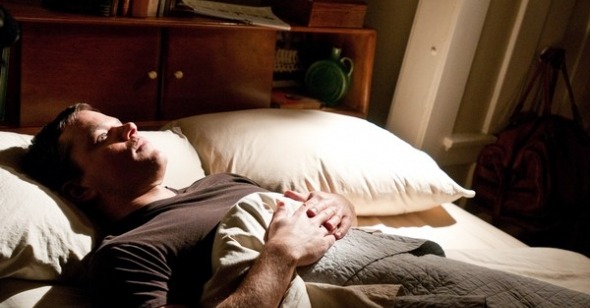Grandpa Clint Who Can Recall His Past Lives
By Leo Goldsmith
Hereafter
Dir. Clint Eastwood; U.S., Warner Bros.
You have to dig pretty deep to find instances of the supernatural in Clint Eastwood’s career. In his more than fifty years of acting and directing, there’s been a conspicuous lack of woo-woo material—the closest you’ll get is a ghostly, whispering wind in Pale Rider and a certain preternaturally mischievous orangutan. This is what’s most striking about Hereafter, Eastwood’s 32nd film as director: it doesn’t just dabble in a subject matter the filmmaker has hitherto eschewed, but goes whole hog, channeling spirits from the netherworld and envisioning the bright lights of the Great Beyond with all the loud music cues and fuzzy CG of an episode of Medium. Unfortunately, this is also the only thing that’s striking about Hereafter. While there’s something admirable about an eighty-year-old filmmaker working outside his comfort zone, his near-complete unsuitability for the project means he’s working outside of ours, too.
The film begins familiarly enough: from the silvery Warner Bros. logo and the first sentimental pluckings of a classical guitar, we know we’re entering Eastwood country. But from there, we’re following the awkward path of a very flimsy script written by Peter Morgan (who’s also departing from his usual contemporary biographical subjects), globetrotting from San Francisco to Paris, with deus ex machina pit-stops at the 2004 Indian Ocean tsunami and the 2005 London bombings in between. The principal contrivance of Morgan’s script—and what a contrivance—is to thread together the narratives of three geographically remote characters dealing with death: High Tension’s Cécile de France as Marie, a hot French telejournalist and Blackberry model who suffers a near-death experience while fatefully vacationing in Anytown, Indonesia; a London boy named Marcus who has lost his twin brother Jason in a freak accident; and finally, Matt Damon as George Lonegan, a former practicing clairvoyant and spirit-whisperer who has given up this vocation (“A life that’s all about death is no life at all!”) to work in some kind of factory.
Eastwood is generally best when exercising restraint; he’s less adept at the “Is that my daughter in there?!?” bombast that has characterized some of his more melodramatic works, and to his credit, Hereafter doesn’t go too far. The tsunami sequence that opens the film—reminiscent of the grand-scale digital crowd sequences in Invictus—isn’t quite as tasteless as it sounds, though it’s more than likely that Eastwood outsourced the work to some computer geeks and merely signed off on it. Even the scenes that offer glimpses of the afterlife are surprisingly few, if utterly conventional: Damon grabs someone’s hands, there’s a loud "WHUMP!" sound, and suddenly we are lost in the vision of a plastic, soft-white haze where lonely silhouettes wander. It’s a pretty bland interpretation, but then Hereafter’s model isn’t Deepak Chopra, but Charles Dickens (explicitly, too: George is a huge Dickens fan, and in one puzzling sequence he even attends a reading of Little Dorrit by Derek Jacobi, playing himself.)
And so Eastwood is able to avoid the pitfalls but also the camp value of Peter Jackson’s The Lovely Bones, and what results is a dull tale of a handful of lonely people mourning their losses in superficial ways. In his search for closure, Marcus googles “what happens after death” and visits a few new-age “Senior Sensitives” and mirror-gazing quacks; Marie nearly tanks both her journalism and modeling careers by writing a book on the “conspiracy of silence” surrounding the “irrefutable eh-vee-danse” of an afterlife; and poor, lonely George tries to pick up Bryce Dallas Howard at his night-class in Italian cooking without prying too awkwardly into her psychic nether regions. The only mild source of suspense in the film come from the clunky machinations of Morgan’s script: will George’s brother Billy (played by Jay Mohr, who is himself back from the dead and seems to have put on a few pounds) convince the ex-medium to take on one more job, Unforgiven style? Will Marcus locate George’s long-defunct website in time to get the supernatural help he needs to save his heroin-addicted mother? The most inventive Eastwood gets is to devise not one, but two, unmotivated scenes in which Cécile de France appears either naked or in her underwear.
Of course, Eastwood has his unflagging defenders, and even this film will find support among those who proclaim the director a “classicist,” a sort of dean of the Hollywood old school. This is a curious designation, though: Eastwood’s recent output has been shockingly (and sometimes laughably) uneven in quality as well as form. Far from being “classical” in style, films like Changeling and Invictus (and now Hereafter) are victims of awkward structures, inconsistent performances, and —worst yet—hasty, breakneck production schedules. (In recent years, Eastwood’s current rate of productivity makes Woody Allen look like Terrence Malick.) Proponents like to cast his work as the mature style of a master and attempt to justify his most ill-advised gestures as the whims of a lion in winter, while detractors can easily and derisively dismiss them as “senior moments.” Probably more accurate is the simple observation that Eastwood likes to work but often bores of his material quickly. A subject of some depth and importance—like the Pacific war, or even Eastwood’s own cinematic iconography—will sustain a lengthier and more committed production; something a little lighter—like a movie about Matt Damon talking to dead people—not so much.
